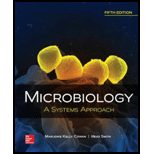
Microbiology: A Systems Approach
5th Edition
ISBN: 9781259706615
Author: Marjorie Kelly Cowan Professor
Publisher: McGraw-Hill Education
expand_more
expand_more
format_list_bulleted
Concept explainers
Question
Chapter 14, Problem 6MCQ
Summary Introduction
Introduction:
Leukocytes are the first line of defense of the immune system. Leukocytes are derived from bone marrow stem cells and have three main categories- lymphocytes, phagocytes, and auxiliary cells.
Expert Solution & Answer
Want to see the full answer?
Check out a sample textbook solution
Students have asked these similar questions
its an open book assignemnt
Describe two different gene regulation mechanisms involving methylation
What is behavioral adapt
Chapter 14 Solutions
Microbiology: A Systems Approach
Ch. 14.1 - Summarize the three lines of host defenses.Ch. 14.1 - Identify two components of the first line of...Ch. 14.1 - Discuss the role of normal biota as a first-line...Ch. 14.2 - Define marker, and discuss its importance in the...Ch. 14.3 - Prob. 5AYPCh. 14.3 - List the components of the mononuclear phagocyte...Ch. 14.3 - Prob. 7AYPCh. 14.3 - Prob. 8AYPCh. 14.3 - Name six types of blood cells that function in...Ch. 14.3 - Prob. 10AYP
Ch. 14.4 - List the four major categories of nonspecific...Ch. 14.4 - Summarize the steps in phagocytosis, and describe...Ch. 14.4 - Outline the steps in inflammation.Ch. 14.4 - Discuss the mechanism of fever and its role in...Ch. 14.4 - Compare and contrast the three different...Ch. 14.4 - Name three types of antimicrobial proteins.Ch. 14 - Ail example of a nonspecific chemical barrier to...Ch. 14 - Which nonspecific host defense is associated with...Ch. 14 - Prob. 3MCQCh. 14 - Which of the following is not a lymphoid tissue?...Ch. 14 - Prob. 5MCQCh. 14 - Prob. 6MCQCh. 14 - Prob. 7MCQCh. 14 - Prob. 8MCQCh. 14 - Which of the following substances is/are not...Ch. 14 - Which of the following is the end product of the...Ch. 14 - The liquid component of clotted blood is called...Ch. 14 - Prob. 12TFCh. 14 - Prob. 13TFCh. 14 - Prob. 14TFCh. 14 - Prob. 15TFCh. 14 - Prob. 1CTQCh. 14 - Prob. 2CTQCh. 14 - Prob. 3CTQCh. 14 - a. Inflammation is characterized by heat, pain,...Ch. 14 - HIV predominantly infects T helper cells, cells...Ch. 14 - Prob. 1VCCh. 14 - Prob. 1CM
Knowledge Booster
Learn more about
Need a deep-dive on the concept behind this application? Look no further. Learn more about this topic, biology and related others by exploring similar questions and additional content below.Similar questions
- 22. Which of the following mutant proteins is expected to have a dominant negative effect when over- expressed in normal cells? a. mutant PI3-kinase that lacks the SH2 domain but retains the kinase function b. mutant Grb2 protein that cannot bind to RTK c. mutant RTK that lacks the extracellular domain d. mutant PDK that has the PH domain but lost the kinase function e. all of the abovearrow_forwardWhat is the label ?arrow_forwardCan you described the image? Can you explain the question as well their answer and how to get to an answer to an problem like this?arrow_forward
- Describe the principle of homeostasis.arrow_forwardExplain how the hormones of the glands listed below travel around the body to target organs and tissues : Pituitary gland Hypothalamus Thyroid Parathyroid Adrenal Pineal Pancreas(islets of langerhans) Gonads (testes and ovaries) Placentaarrow_forwardWhat are the functions of the hormones produced in the glands listed below: Pituitary gland Hypothalamus Thyroid Parathyroid Adrenal Pineal Pancreas(islets of langerhans) Gonads (testes and ovaries) Placentaarrow_forward
- Describe the hormones produced in the glands listed below: Pituitary gland Hypothalamus Thyroid Parathyroid Adrenal Pineal Pancreas(islets of langerhans) Gonads (testes and ovaries) Placentaarrow_forwardPlease help me calculate drug dosage from the following information: Patient weight: 35 pounds, so 15.9 kilograms (got this by dividing 35 pounds by 2.2 kilograms) Drug dose: 0.05mg/kg Drug concentration: 2mg/mLarrow_forwardA 25-year-old woman presents to the emergency department with a 2-day history of fever, chills, severe headache, and confusion. She recently returned from a trip to sub-Saharan Africa, where she did not take malaria prophylaxis. On examination, she is febrile (39.8°C/103.6°F) and hypotensive. Laboratory studies reveal hemoglobin of 8.0 g/dL, platelet count of 50,000/μL, and evidence of hemoglobinuria. A peripheral blood smear shows ring forms and banana-shaped gametocytes. Which of the following Plasmodium species is most likely responsible for her severe symptoms? A. Plasmodium vivax B. Plasmodium ovale C. Plasmodium malariae D. Plasmodium falciparumarrow_forward
arrow_back_ios
SEE MORE QUESTIONS
arrow_forward_ios
Recommended textbooks for you

 Medical Terminology for Health Professions, Spira...Health & NutritionISBN:9781305634350Author:Ann Ehrlich, Carol L. Schroeder, Laura Ehrlich, Katrina A. SchroederPublisher:Cengage Learning
Medical Terminology for Health Professions, Spira...Health & NutritionISBN:9781305634350Author:Ann Ehrlich, Carol L. Schroeder, Laura Ehrlich, Katrina A. SchroederPublisher:Cengage Learning Biology (MindTap Course List)BiologyISBN:9781337392938Author:Eldra Solomon, Charles Martin, Diana W. Martin, Linda R. BergPublisher:Cengage Learning
Biology (MindTap Course List)BiologyISBN:9781337392938Author:Eldra Solomon, Charles Martin, Diana W. Martin, Linda R. BergPublisher:Cengage Learning Human Biology (MindTap Course List)BiologyISBN:9781305112100Author:Cecie Starr, Beverly McMillanPublisher:Cengage Learning
Human Biology (MindTap Course List)BiologyISBN:9781305112100Author:Cecie Starr, Beverly McMillanPublisher:Cengage Learning




Medical Terminology for Health Professions, Spira...
Health & Nutrition
ISBN:9781305634350
Author:Ann Ehrlich, Carol L. Schroeder, Laura Ehrlich, Katrina A. Schroeder
Publisher:Cengage Learning

Biology (MindTap Course List)
Biology
ISBN:9781337392938
Author:Eldra Solomon, Charles Martin, Diana W. Martin, Linda R. Berg
Publisher:Cengage Learning

Human Biology (MindTap Course List)
Biology
ISBN:9781305112100
Author:Cecie Starr, Beverly McMillan
Publisher:Cengage Learning
Immune System and Immune Response Animation; Author: Medical Sciences Animations;https://www.youtube.com/watch?v=JDdbUBXPKc4;License: Standard YouTube License, CC-BY
Immune response: summary; Author: Dr Bhavsar Biology;https://www.youtube.com/watch?v=ADANgHkX4OY;License: Standard Youtube License